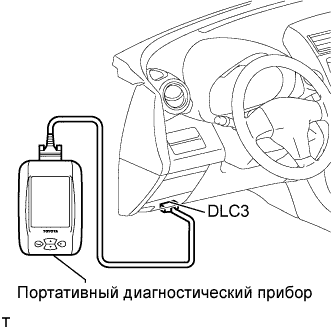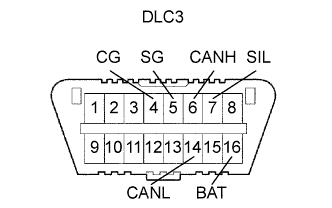Automatic Transaxle System -- Diagnosis System |
| EURO-OBD |
When troubleshooting Europe On-Board Diagnostic (Euro-OBD) vehicles, the vehicle must be connected to an OBD scan tool (complying with ISO 15765-4). Various data output from the vehicle's ECM can then be read.
Euro-OBD regulations require that the vehicle's on-board computer illuminates the Malfunction Indicator Lamp (MIL) on the instrument panel when the computer detects a malfunction in:
The emission control system/components.
The powertrain control components (which affect vehicle emissions).
The computer.
In addition, the applicable Diagnostic Trouble Codes (DTCs) prescribed by ISO 15765-4 are recorded in the ECM memory.
If the malfunction does not reoccur in 3 consecutive trips, the MIL turns off automatically but the DTCs remain recorded in the ECM memory.
To check DTCs, connect the intelligent tester to the Data Link Connector 3 (DLC3) of the vehicle. The tester displays DTCs, the freeze frame data and a variety of the engine data.
The DTCs and freeze frame data can be erased with the tester (see page RAV4_ACA30 RM000000W7701GX.html).
 |
 |
| M-OBD (Except European spec.) |
When troubleshooting Multiplex On-Board Diagnostic (M-OBD) vehicles, the vehicle must be connected to the intelligent tester. Various data output from the ECM can then be read.
OBD regulations require that the vehicle's on-board computer illuminates the MIL on the instrument panel when the computer detects a malfunction in:
The emission control system/components.
The powertrain control components (which affect vehicle emissions).
The computer.
In addition, the applicable DTCs are recorded in the ECM memory.
If the malfunction does not reoccur in 3 consecutive trips, the MIL turns off automatically but the DTCs remain recorded in the ECM memory.
 |
| NORMAL MODE AND CHECK MODE |
The diagnosis system operates in "normal mode" during normal vehicle use. In normal mode, "2 trip detection logic" is used to ensure accurate detection of malfunctions. "Check mode" is also available to technicians as an option. In check mode, "1 trip detection logic" is used for simulating malfunction symptoms and increasing the system's ability to detect malfunctions, including intermittent malfunctions.
| 2 TRIP DETECTION LOGIC |
When a malfunction is first detected, the malfunction is temporarily stored in the ECM memory (1st trip). If the same malfunction is detected during the next drive cycle, the MIL is illuminated (2nd trip).
| FREEZE FRAME DATA |
Freeze frame data records the engine conditions (fuel system, calculated load, engine coolant temperature, fuel trim, engine speed, vehicle speed, etc.) when a malfunction is detected. When troubleshooting, freeze frame data can help determine if the vehicle was running or stopped, if the engine was warmed up or not, if the air-fuel ratio was lean or rich, and other data from the time the malfunction occurred.
The intelligent tester records freeze frame data in 5 different instances: 1) 3 times before the DTC is set, 2) once when the DTC is set, and 3) once after the DTC is set. These data can be used to simulate the vehicle's condition around the time when the malfunction occurred. The data may help find the cause of the malfunction, or judge if the DTC is being caused by a temporary malfunction or not.
 |
| DATA LINK CONNECTOR 3 (DLC3) |
The vehicle's ECM uses the ISO 15765-4 for communication protocol. The terminal arrangement of the DLC3 complies with SAE J1962 and matches the ISO 15765-4 format.
Symbols (Terminal No.) Terminal Description Condition Specified Condition SIL (7) - SG (5) Bus "+" line During transmission Pulse generation CG (4) - Body ground Chassis ground Always Below 1 Ω SG (5) - Body ground Signal ground Always Below 1 Ω BAT (16) - Body ground Battery positive Always 9 to 14 V CANH (6) - CANL (14) HIGH-level CAN bus line Ignition switch off* 54 to 69 Ω CANH (6) - Battery positive HIGH-level CAN bus line Ignition switch off* 1 MΩ or higher CANH (6) - CG (4) HIGH-level CAN bus line Ignition switch off* 200 Ω or higher CANL (14) - Battery positive LOW-level CAN bus line Ignition switch off* 1 MΩ or higher CANL (14) - CG (4) LOW-level CAN bus line Ignition switch off* 200 Ω or higher
 |
- УКАЗАНИЕ:
- *: Before measuring the resistance, leave the vehicle as is for at least 1 minute and do not operate the ignition switch, other switches or doors.
- УКАЗАНИЕ:
- Connect the cable of the intelligent tester to the DLC3, turn the ignition switch on (IG) and attempt to use the tester. If the screen displays UNABLE TO CONNECT TO VEHICLE, a problem exists in the vehicle side or the tester side.
If communication is still not possible when the tester is connected to another vehicle, the problem is probably in the tester itself. Consult the Service Department listed in the tester's instruction manual.
| CHECK MIL |
Check that the MIL illuminates when turning the ignition switch on (IG).
If the MIL does not illuminate, there is a problem in the MIL circuit (see page RAV4_ACA30 RM000000WZ1015X.html).When the engine is started, the MIL should turn off.
| ALL READINESS |
For this vehicle, using the intelligent tester allows readiness codes corresponding to all DTCs to be read. When diagnosis (normal or malfunctioning) has been completed, readiness codes are set.